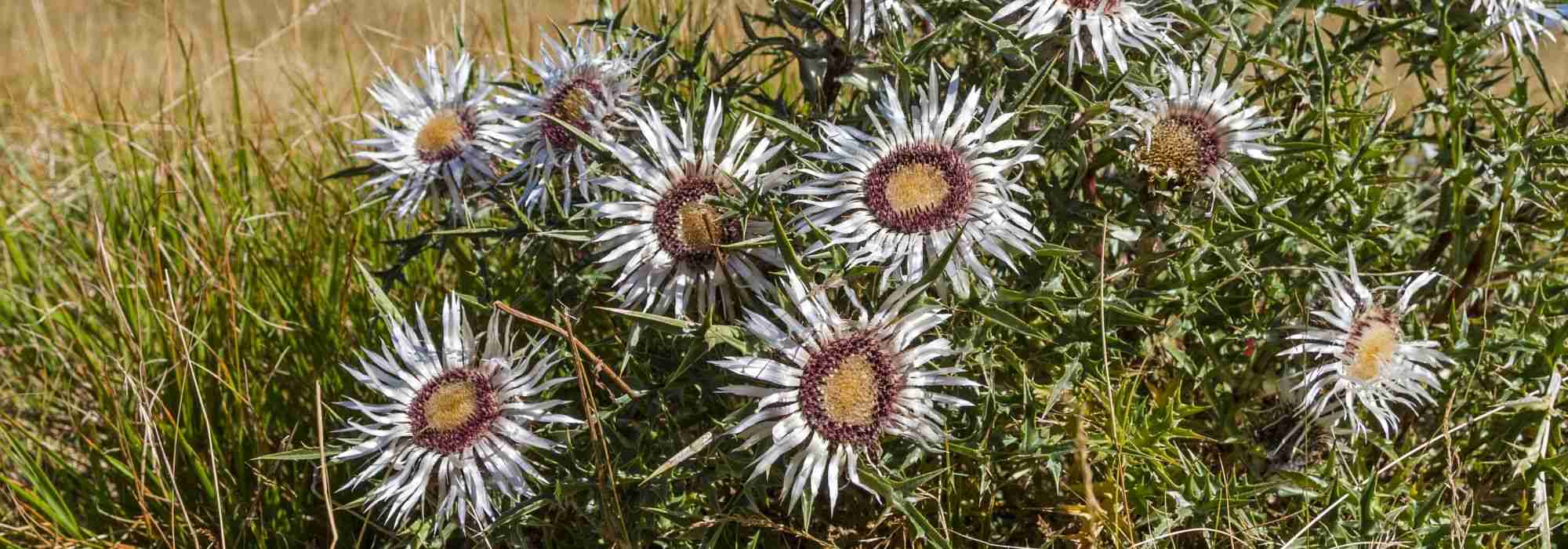
Carline: planting, growing
Contents
Carline in a nutshell
- Carline is a unique species of thistle perfect for rockeries or poor, stony soil.
- It flowers without maintenance from spring to summer, producing large heads atop a rosette of very thorny leaves.
- It thrives in full sun in very well-drained, poor soil.
- It is a remarkably graphic and truly original perennial, both in the garden and in dried bouquets.
A word from our expert
Thistles also known as “Wild Artichoke” or “Shepherd’s barometer”, are rare and original perennial plants, cousins of thistles. From this close relationship, they have retained radiant flowers adorned with numerous bracts emerging from a wide rosette of strongly spiny leaves.
The genus includes Carlina acaulis, stemless carline, also called “Alpine Carline”, whose roots are used in phytotherapy for their medicinal properties, as well as Carlina acanthifolia or “Carline with Acanthus-like Leaves” which stands out from its relatives with its large heads and more imposing growth (up to 1 m in diameter).
Thistles display bright and natural hues and are among the best flowers for creating lovely dried bouquets.
Very hardy, these mountain thistles thrive easily in perfectly drained and poor soil: they are a boon for dry, ungrateful, stony lands, and rockeries where they self-seed.
In rockeries, sunny borders, along pathways, or as a bouquet for your interior, discover Thistles, these perennials that are not lacking in spines!
Description and botany
Botanical data
- Latin name Carlina
- Family Asteraceae
- Common name Stemless Carline, Alpine Carline, Acanthus-leaved Carline, Silver Thistle, Wild Artichoke,
- Flowering June to October
- Height 0.20 to 1 m
- Exposure Sun
- Soil type Dry
- Hardiness -15°C
Carline, also known as “Wild Artichoke”, “Shepherd’s Barometer”, “Silver Thistle”, or “Chardonnette”, is a species of thistles in the Asteraceae family. This perennial mountain plant is primarily native to southern and eastern Europe, North Africa, and temperate Asia, where it grows on arid mountain slopes, in sunny meadows, and on fallow land. It can still very rarely be found in the mountains of southern and eastern France, and it is now part of the protected species.
The genus Carlina comprises 25 species, including Carlina acaulis, Carlina acaulis ssp.simplex, and Carlina acanthifolia (Acanthus-leaved Carline or artichoke carline), which are stemless Carlines that are actually supported by a very short stem. There are upright Carlines such as Carlina vulgaris or common carline, Carlina lanata, woolly carline, and Carlina macrocephala, large-flowered carline.
From a taproot that anchors firmly in the soil, the plant forms a large rosette of leaves 20 to 70 cm high and 50 cm wide, up to 1 m in diameter for Carlina acanthifolia.
It is a short-lived herbaceous perennial but can persist for a long time in a garden as it can self-seed in light soils when its faded heads are not removed.
The foliage, semi-evergreen in mild winters, consists of long, spiny, alternate, and narrow leaves with very jagged edges and sharp thorns. These spiky leaves, sometimes up to 30 cm long, are silver-green, slightly white and velvety on the underside.
From spring until the end of summer, each rosette of heavily spined leaves is adorned in its centre with surprising round flowers. They bloom in solitary heads 2 to 15 cm in diameter at the top of each stem. The Acanthus-leaved Carline is distinguished by its very large heads. They consist of a fluffy central disc in cream to reddish-bronze, surrounded by tough, finely serrated bracts that mimic petals. These bracts are thin and rigid like a sheet of paper (papyraceous).
These heads have the particularity of closing to protect themselves when the weather is humid or rainy, which has earned the plant the nickname “Shepherd’s Barometer”. The floral buds are edible and can be consumed like artichokes.
These bright and spiny corollas come in natural shades ranging from white to silver-pink, including pale yellow or orange, and can be integrated into dried bouquets of very long duration. This remarkably generous melliferous flowering renews continuously throughout the summer, attracting numerous pollinating insects.
The flowers produce small, hairy fruits topped with feathery bristles that self-seed spontaneously, dispersed by the wind.
The root of the stemless Carline is used in herbal medicine for its diuretic properties and to treat skin inflammations.
Species and varieties of Carlines
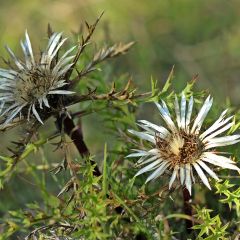
Carlina acaulis subsp. simplex
- Flowering time July to September
- Height at maturity 20 cm
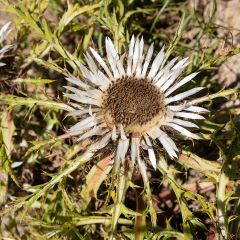
Carlina acaulis subsp. simplex Bronze
- Flowering time July to September
- Height at maturity 20 cm
Discover other Carlina
View all →Available in 1 sizes
Available in 1 sizes
Available in 1 sizes
Planting carline
Where to plant it?
Very hardy, the Carline withstands cold down to -20°C. It thrives in dry, poor, and stony soils found in its natural habitat. This plant is the epitome of a sun-loving, dry garden plant! It requires perfectly drained, poor, and rather calcareous soil, only fearing overly wet conditions where its roots may rot. It can adapt to any ordinary soil as long as it does not retain water. It will become leggy in fertile soils.
Provide it with a dry, warm, and sunny location. This flowering plant is a boon for dry, stony soils, in rockeries, on dry slopes, or in dry lawns, and it serves as groundcover in the most challenging areas of the garden. It is also useful for filling gaps in a perennial bed with other equally undemanding plants.
When to plant Carline?
The Carline should be planted in spring from February to April, depending on the region, when temperatures rise and especially once the risk of frost has passed, or in autumn from September to November in warm climates.
How to plant it?
The Carline requires perfectly drained soil. In heavy, compact, or clayey soil, it is essential to incorporate gravel or coarse sand at the bottom of the planting hole. If your ground retains too much water, plant it on a slope or in a raised rockery. Space the plants about 25 cm apart in all directions, aiming for 5 to 6 plants per square metre. Flowering will begin in the second year after planting.
In open ground
- Dig a hole deeper than it is wide
- Loosen the soil well to aerate it
- Lighten it with coarse sand and spread a layer of gravel at the bottom of the hole
- Plant in the centre of the hole without burying the collar
- Backfill and lightly firm the soil
- Water well at planting, then keep it moist without overwatering to avoid drowning the roots
In a pot: pot cultivation is possible, but its growth and lifespan will be limited; the Carline’s deep, vertical taproot requires ample depth to anchor itself.
Sowing
You can sow your Carlines after collecting the seeds from the garden, sowing in place in spring in warmed soil, therefore not before April or May, keeping it barely moist during germination. You can also choose to sow directly in pots, in a mix of potting soil, sand, and garden soil. These sowings will produce flowers the following year.
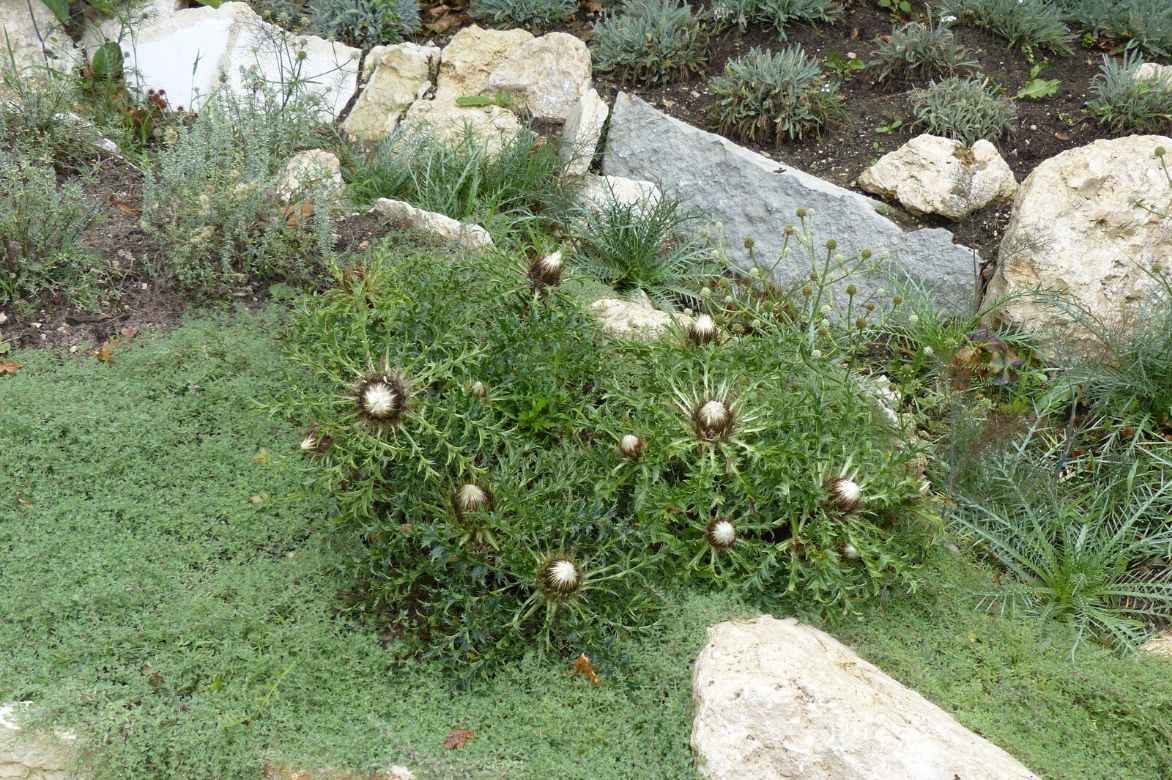
Read also
15 plants for a sunny rockeryCare
Once well established, Carlines require very little maintenance as long as the soil remains well-drained, as they are particularly sensitive to excess water. During the first two summers, water once a week, then only in cases of prolonged drought and always sparingly. They are mainly vulnerable to diseases in heavy, poorly drained, overly moist soil.
In pots, water a little more frequently while always allowing the substrate to dry out well between waterings. In rainy regions, bring your pots to a sheltered place, water them sparingly during winter, and take them out again in May.
These plants are undemanding: no fertiliser is needed, and it should even be avoided.
Regularly remove faded flowers to prevent exhausting the plant, which could lead to premature disappearance.
In autumn, put on gloves and simply clean the foliage by cutting away dry or faded parts and removing the dead flowers.
Multiplication
Carline easily multiplies in the garden through spontaneous sowing. If you collect carline seeds, sow each seed 1 cm deep every 25 cm in previously loosened, light, and well-draining soil. Lightly cover them with compost. Water and keep just moist during germination, which takes 2 to 4 weeks.
Pairing ideas
Carlines always bring an extra touch of exoticism to a garden, offering both an enchanting and elegant flair. They are essential in dry and sun-drenched wild gardens.
Flowering throughout the summer, they make good companions with other rockery perennials that are equally undemanding and drought-tolerant, such as blue fescue, creeping sedums, delospermas, dwarf wormwoods, or small lavenders, as well as with Agaves for more contemporary combinations.
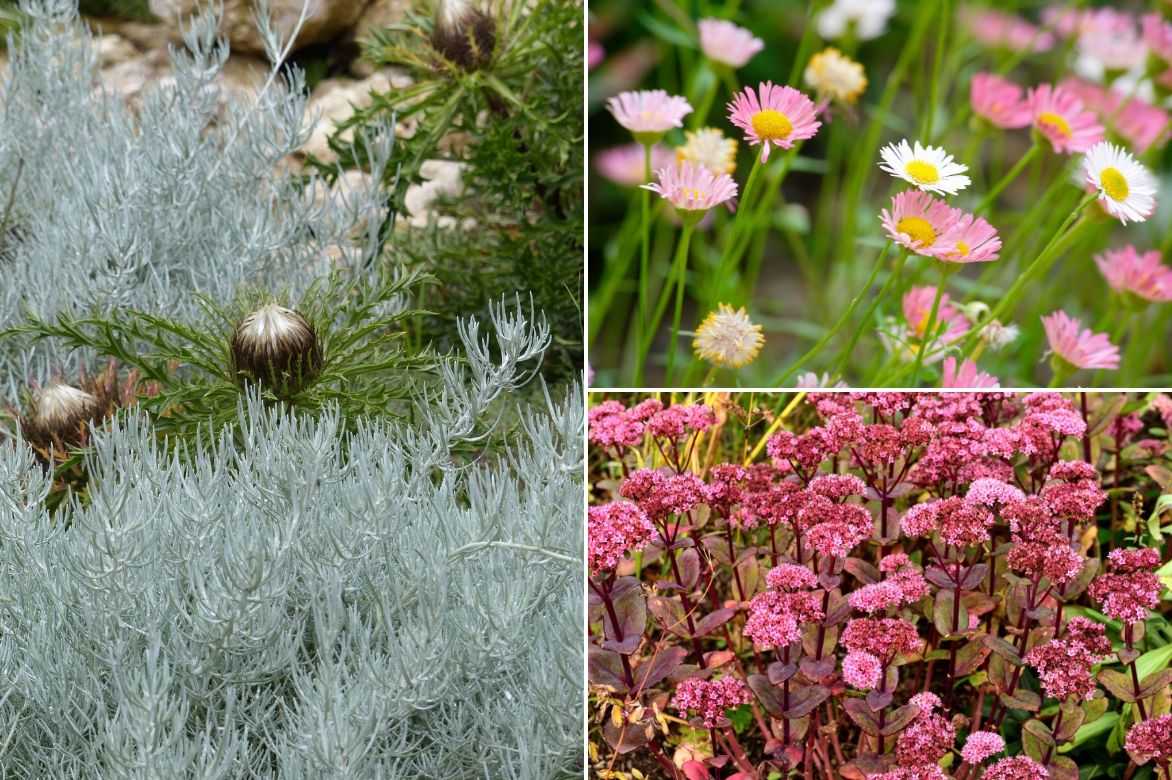
A combination idea: Carline, curry plant, fleabane and purple stonecrop (‘Chocolate Cherry’, ‘Dark Magic’ for example)
In borders, they pair well with very floriferous dry-soil perennials such as Echinops, Erigeron karvinskianus, Echinaceas, or annuals like everlasting flowers for complementary colour contrasts.
As they bloom their heads sometimes until the first light of autumn, they can blend with late-flowering perennials such as heleniums, gaillardes, and autumn stonecrops.
Useful resources
- Discover our flower seeds for cut flower arrangements
- All our plants for the dry garden
- Subscribe!
- Contents
. Whether you are a seasoned gardener or just starting out, Carlina is a genus that can bring both challenge and reward to your gardening adventures. Stemless Carlina: Everything You Need to Know](https://en.promessedefleurs.eu/blogwp/wp-content/uploads/2020/06/carline-tout-savoir.jpg)































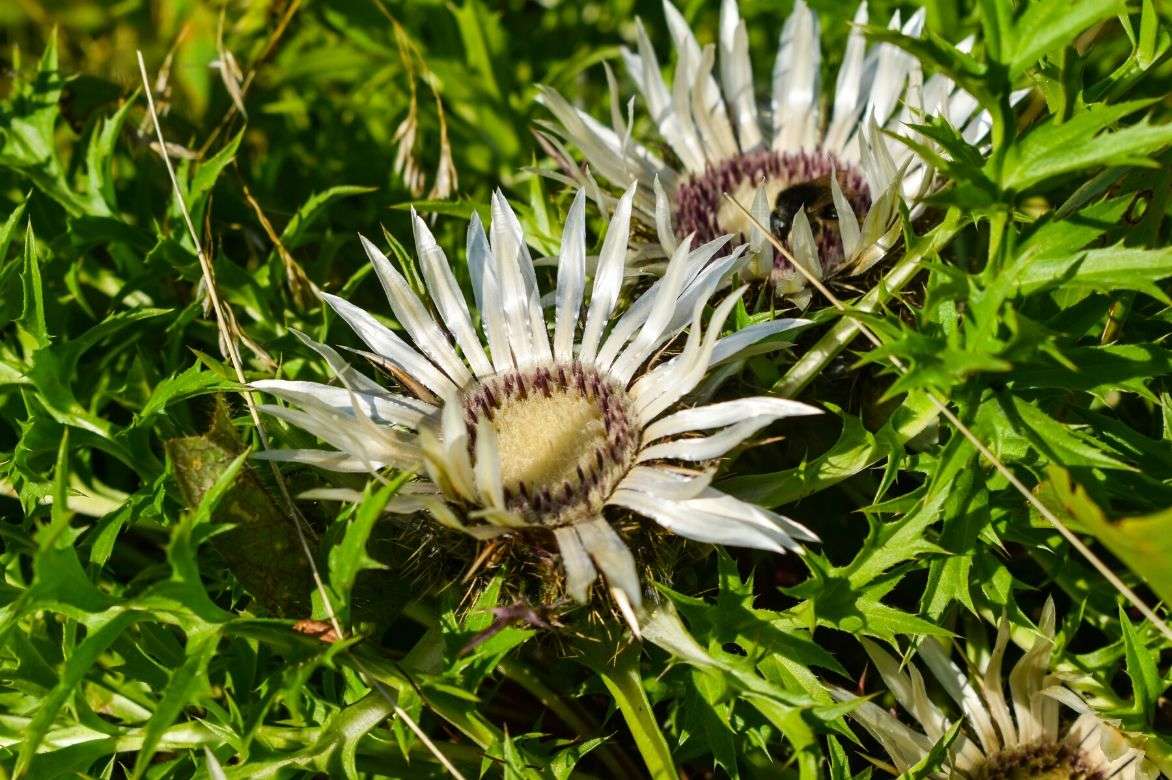

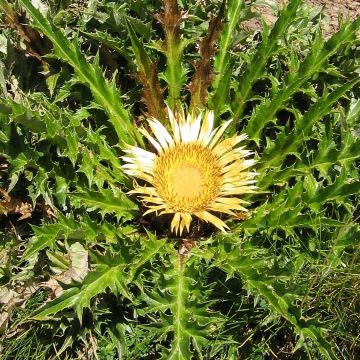

Comments